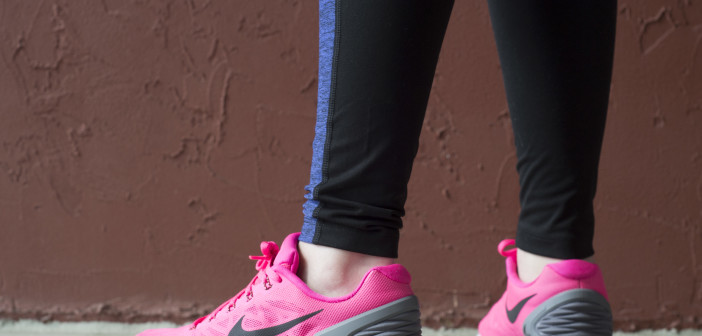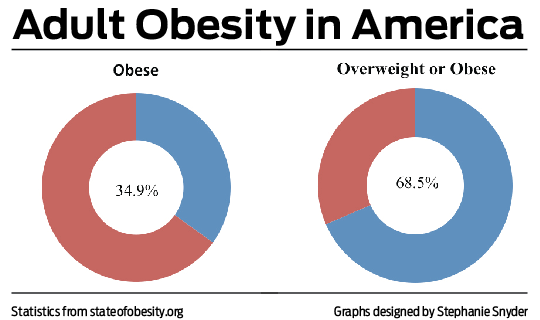First thing in the morning, we roll over, mixed up in our comforter and slam our hand on the overzealous alarm clock before peeling our eyes open. We go through a daily routine of email and text message checks, scarfing down breakfast or skipping it altogether. We jump in the shower, throw on the cleanest clothes we have and rush to our morning meeting, class or just the typical work day. For women in particular, the outfits range, but one commonality between most every woman’s wardrobes is yoga pants: colored, patterned or black stretchy pants. You see it everywhere from the work place, to the bar and just walking down the street.
Yoga pants are a type of flexible, form-fitting pants designed for the practice of yoga as well as other physical activities that involve a lot of movement, bending and stretching.
Now, almost every woman, adult or child has made the yoga pant trend a staple in their wardrobe. It works the same for men with their jogging pants and athletic shoes. Pair it with a suit and tie and it can pass for work attire, or throw them on as you roll out of bed for class. Almost everyone has been caught in the act of sporting athletic wear as their everyday attire.
Now, the question is who is actually in the gym and who’s just wearing it for the trend or the comfort? The only way to tell is if you ask the guy on the street rocking his Nikes to the office, or the woman fashioning the oversized shirt, jacket, yogas and black leather boots.
Is the idea of working out and dressing the part becoming a trend rather than a way to live life?
Statista, the statistics portal, says that the market for sports, like track, basketball swimming etc., in the United States has a projected value of $63 billion in 2014. This number represents the exercise equipment, athletic apparel and footwear being sold in stores and online. Although the numbers are soaring for Nike, Lululemon, Adidas and the like, the comparison between sales and an individual’s personal health does not statistically correlate.
In September 2014 the Centers for Disease Control and Prevention reported that 34.9 percent or 78.6 million people in the United States are considered obese, which is about one third of the population.
The numbers are not going unnoticed. David Sutton, personal trainer for two years at Spa Chakra Luxury Fitness, believes the stats exemplify a deeper meaning than just an uneven balance.
“I think there is definitely a lot of consciousness on image… obesity in younger and older people is on the rise,” says Sutton. “But the market for fitness wearables and fitness clothing is also on the rise. So, I mean, they both can’t go up. One has to come down. If people are buying all these clothes so they can live super active lifestyles, obesity wouldn’t be climbing as much as it is.”
For athletic apparel consumer Jordan Scherpe, there are factors that could possibly explain the rise in the athletic apparel trend.
“I think that a lot of fitness clothes are more attractive to some larger consumers, because they don’t have to worry about the clothing being too tight or not fitting them the way they want them to,” said Scherpe. “I also think that sometimes fitness wear tends to be stretchier and more form fitting and consumers might like that as well. However, larger consumers might have the impression that if they dress the way they want to look then they’ll start to look that way.”
Consumers of all body types are bringing home shopping bags from various athletic stores, but their use for them varies depending on their lifestyle. Regardless of the athletic apparel use, people will fashion them in the gym and out of the gym, no matter the occasion.
“It’s actually gotten to the point where people will start wearing yoga pants tucked into their boots with a nice top when they’re doing school presentations, because the line is so blurred in the clothing industry right now,” says Scherpe.
The fashion trends in the departments of stores are starting to blend, which is making it more difficult to distinguish between whether someone is actively living a healthy life or if they are actively living their personal style.
“I think society is picking up on (the trend), which is why you’re seeing a lot more athletic stores open up,” says Naperville resident Paul Lopes. “It’s not that society is getting healthier. I do believe as a society we are concerning ourselves more with body image, and people are training themselves and working out a little more towards the body images that they see in magazines.”
Lopes notices the trend not only around town, but on his social media feeds on a daily basis. He believes it to be a perception that people are trying to give off to the public.
“You see a lot of posts on Facebook and social media with stuff like, ‘I just ran 13 miles’ with their Nike+ workout plan,” says Lopes. “I think it’s to have an athletic showing, but they’re not actually doing all that. I feel like I see that all over my Facebook feed; what they’re doing, what they’re eating, how they’re healthy and so fit, but then you see them and they’re not really healthy and fit. It’s more like an online presence and showing off, but no one’s actually putting forth that effort.”
The trend that’s plastered all over social media and walking down your streets has to have started somewhere. For Sutton, it begins with the athletic companies. The size of the U.S. market for workout clothes grew by five percent a year on average, from roughly $54 billion to $68 billion, according to analysts at Barclays, an international bank and financial services company.
“I think that the fitness apparel industries are creating this image that people live up to, or try to live up to,” says Sutton. “I think that extends to the fitness wearables as well. When people are buying these things, whether they plan on using them correctly, it’s all about the image.”
It’s not a myth either. The Wall Street Journal recently reported on a new concept called “Athleisure” that the athletic apparel industries are using to describe the clothing lines they are putting in stores. With that, there is a blame factor made by some consumers that feel like the industry is what’s putting the idea of working out in consumers’ heads but not acting on living a healthy lifestyle.
“I think (the trend) is kind of both negative and positive,” said Scherpe. “It’s positive in the way that it’s not really hurting anybody. So, anybody can wear it…However, it could be negative by people thinking ‘Oh, I don’t have to go workout.’ It’s just causing misconceptions of what the products are actually meant for.”


